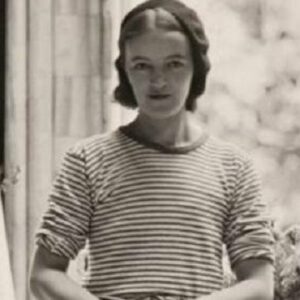Barbara Hepworth was a sculptor and artist from England. She was one of the twentieth century’s most eminent and influential female artists. Her artistic creations were among the country’s first abstract sculptures. As the eldest of the Hepworth family’s four children, she developed an early interest in natural forms and textures and decided to pursue a career as a sculptor as a teenager. She studied sculpture at the Leeds School of Art and later earned a county scholarship to study at the Royal College of Art. After completing her college studies, she traveled to Italy to learn the art of marble carving. Meanwhile, she married and returned to London, where she established herself as a leading figure in the ‘new movement’ associated with direct carving. She participated in successful joint exhibitions and received critical acclaim for her early works, which appeared naturalistic with simplified features. Her artistic ability developed over time, and she began experimenting with new wood carvings incorporating string and metal. Later in her career, increased demand and public commissions prompted her to employ assistants and also to produce bronze editions. She devoted the remainder of her life to mentoring dozens of other artists and writers. She is rightfully regarded as the most enduring artist of her generation, her landscapes and linear abstract works awe-inspiring in their clarity and vision.
Childhood & Adolescence
Jocelyn Barbara Hepworth was born on January 10, 1903, in Wakefield, West Riding of Yorkshire, to Herbert Hepworth and his wife, Gertrude. Herbert Hepworth was a civil engineer who later became County Surveyor.
She was the eldest of her family’s four children. She attended Wakefield Girls’ High School for her early education and later earned a scholarship to the Leeds School of Art.
At art school, she met Henry Moore, a fellow student with whom she developed a lifelong friendship and who had a significant influence on her work.
She was awarded a county scholarship to the Royal College of Art (RCA) in 1921 and graduated with a diploma in 1924.
Career of Barbara Hepworth
Hepworth traveled to Florence, Italy in 1924 on a West Riding Travel Scholarship after completing her studies at the RCA. In Italy, she studied marble carving with Giovanni Ardini, a master sculptor.
In 1926, she returned to London with her husband, where the two of them shared an apartment and exhibited their works.
In 1933, she co-founded the Unit One art movement with artists Paul Nash and Ben Nicholson. In British art, the movement sought to reconcile surrealism and abstraction.
In 1935, she created ‘Three Forms,’ an abstract sculpture comprised of a sphere and two nearly oval shapes, which critics interpreted as a representation of the birth of her triplets.
In 1937, she created the layout for ‘Circle: An International Survey of Constructivist Art,’ a 300-page book devoted to Constructivist artists.
She relocated with her children to Cornwall in southwestern England during the Second World War and later produced works such as ‘Tides’ (1946).
In 1949, she co-founded the Penwith Society of Arts at the Castle Inn with a number of other artists, including Peter Lanyon and Bernard Leach.
She began working with bronze in 1950. The Arts Council commissioned her the following year to create a piece for the Festival of Britain. The resulting work, titled ‘Contrapuntal Forms,’ featured two Irish limestone figures and was displayed on London’s South Bank.
In the 1950s, she presented ‘Groups,’ an experimental series comprised of clusters of small anthropomorphic forms carved from marble so thin that their translucence imparts a magical sense of inner life.
Throughout the 1960s, she was commissioned to create truly monumental sculptures, one of which is ‘Four-Square Walk Through’ (1966), a colossal geometrical work.
She also experimented with lithography later in her career, producing two lithographic suites. The latter, titled ‘The Aegean Suite’ (1971), was inspired by Hepworth and Margaret Gardiner’s 1954 trip to Greece.
Significant Works of Barbara Hepworth
One of her most well-known sculptures is ‘Single Form,’ which she created in memory of her friend and collector, former United Nations Secretary General Dag Hammarskjöld. The sculpture is currently on display in New York City’s United Nations plaza.
Awards and Accomplishments
She was made a Commander of the Order of the British Empire in 1958. (CBE).
She was appointed Dame Commander of the Order of the British Empire in 1965. (DBE).
She was awarded the Freedom of St. Ives in 1968 for her significant contributions to the town.
In 1973, she was inducted into the American Academy of Arts and Letters as an honorary member.
Personal History and Legacies
In 1925, after traveling through Siena and Rome with John Skeaping, another sculptor, she married him in Florence. They welcomed a son, Paul, in 1929, but the couple divorced in 1933.
In 1933, she married painter Ben Nicholson, with whom she had triplets in 1934: Rachel, Sarah, and Simon. In 1951, the couple divorced.
Barbara Hepworth died on May 20, 1975, at the age of 72, in an accidental fire at her Trewyn Studios in St. Ives, Cornwall.
Estimated Net Worth
Barbara is one of the wealthiest sculptors and is listed on the list of the most popular sculptors. Barbara Hepworth’s net worth is estimated to be around $1.5 million, based on our analysis of Wikipedia, Forbes, and Business Insider.


